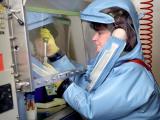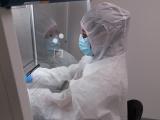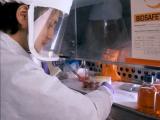Apr 7, 2006 (CIDRAP News) Under a schedule laid out yesterday by federal agriculture officials, a nationwide livestock identification system to help in the investigation and control of animal disease outbreaks will be fully operational by 2009.
"A long-term goal is to be able to identify all animals and premises that have had direct contact with the disease of concern within 48 hours of discovery," Agriculture Secretary Mike Johanns said at a press conference on the plan.
The US Department of Agriculture (USDA) began working on its National Animal Identification System (NAIS) after the first US case of bovine spongiform encephalopathy, or mad cow disease, was discovered in December 2003. After that case and the two subsequent BSE cases, it took investigators weeks or longer to trace other cattle that might have been exposed to the disease.
"A national animal ID system will dramatically improve our ability to respond to animal disease outbreaks," Johanns said at the news conference. The system "will help animal health officials identify the birthplace of a diseased animal and shorten the time required to trace the animal's history to identify other potentially exposed animals."
Johanns said the US livestock industry will need the tracking system to stay competitive with other beef exporters, such as Australia and Canada. "Traceability is being used as a marketing tool by several countries," he said. "For example, Australia is aggressively marketing animal traceability to gain a competitive advantage over us."
The NAIS is a cooperative and voluntary effort of the federal government, states, Indian tribes, and industry. Under the plan, each newborn animal will get a 15-digit identification number linked to its birthplace. The plan also calls for the registration of all livestock premisesfarms, feedlots, sale barns, packing plants, and other facilitiescoupled with the creation of animal tracking databases managed by the states and industry groups.
Parts of the system are already built. Registration of premises was under way in all 50 states and two territories by August 2005, and 235,000 premises, roughly 10% of the total, have registered, USDA officials said. Also, animal identification began last month.
An implementation plan released by the USDA yesterday calls for registration of 70% of premises and identification of 40% of animals by January 2008. By January 2009, the USDA aims to have all facilities registered and identification procedures in place for all newborn animals. In addition, the agency hopes to have complete movement data available for 60% of animals under 1 year old by that time.
Under the current plan, industry participation in the NAIS is voluntary, but Johanns said it could become mandatory if producers and other industry groups are slow to sign on. The USDA has authority to make the program mandatory without new legislation, he told reporters.
Newspaper reports have described cattle producers as wary of the plan, particularly the cost of the identification tags and the privacy of data. Meanwhile, some consumer groups have pressed the USDA to move faster and to make the plan mandatory.
If only 50% of animals are registered, "It is not a workable system," Johanns said. "But I think producers . . . understand that, and my hope is that they will embrace what we are offering, which is a voluntary approach."
Yesterday the USDA released technical standards to provide for the linkage of private animal tracking databases with the NAIS. The agency will sign agreements with private databases that meet the standards, officials said.
By early next year, the USDA expects to have a system in place that will permit state and federal animal health officials to query the NAIS and private databases during disease investigations. The system will be called the Animal Trace Processing or Metadata system, the agency said.
Johanns described the NAIS as an enormous undertaking. "At any given time you have 90 to 100 million head of cattle in the United States. There has never been a system put in place that would deal with that kind of magnitude," he said. "We are talking about a system that literally says from the time of their birth through the entire chain, we will trace that animal until we can ascertain where the animal was finally processed."
Given the scale of the program, the USDA's implementation schedule is "very amibitious," Johanns said. "We are asking the industry, not just cattle but in other areas, to really change how they look at things."
The primary focus of the NAIS now is on cattle, officials said. But working groups are looking at the extension of the system to other species, including swine, sheep and goats, horses, deer and elk, and even llamas, said Dr. John Clifford, the USDA's chief veterinarian.
The USDA has spent about $84 million on the system so far, said Johanns.
See also:
Transcript of Apr 6 USDA news conference
USDA NAIS site
http://www.aphis.usda.gov/traceability/
















